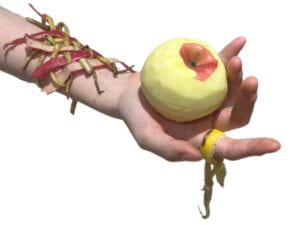
What does “苹水香缝” mean?
“苹” refers to apples in Chinese, “香” is the first character of bananas in Chinese, and “缝” means sewing. Apples and bananas sewn together, creating a new textile. Additionally, in Chinese, these four characters form a homophone of the idiom “萍水相逢,” which means “to meet by chance.”
Working Process:
In this in-class assignment to create a new textile, Chanel and I formed a group and came up with our fabric called “苹水香缝”(Apple-Banana Stitch). Our design journey started quite spontaneously, as we were both feeling hungry 😋 at the time when we were given the freedom to wander and search for materials. We decided to grab some snacks, so we headed to the café on the third floor. There, we spotted apples 🍎 and bananas 🍌 and decided to purchase one of each as our materials.
(By the way, the fruit sold at school is really expensive! It’s unbelievable that such small apples and bananas cost ten yuan!)
Normally, we would only pay attention to whether they tasted good and discard their peels, but this time, we decided to make the most out of everything. While enjoying the sweetness of the apples and bananas, we also explored the different textures of their peels!
We headed to the cafeteria on the basement floor and borrowed a small knife to peel the apple. Chanel peeled the apple while I took charge of tearing open the banana peel. During this process, we noticed that the textures of the inside and outside of the apple and banana peels were very different. The banana peel varied in thickness when torn, both inside and outside, and they felt different to the touch. Normally, when we touch them, we feel a 3D object, but now, they are stretched out and laid flat on a 2D plane.
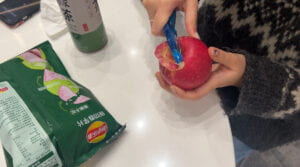
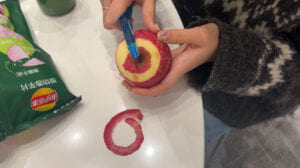
We decided to intricately weave the inside and outside of the banana peel with the apple peel to create an accessory that could be worn on the skin. (This process was actually quite difficult, and we were very afraid of tearing the peels or not having enough length.) After finishing, we wanted to take photos and found that the peeled apple looked beautiful when held in the hand, which perfectly illustrated the different sensations between 3D and 2D in textiles.
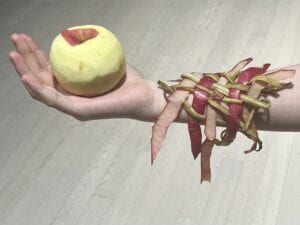
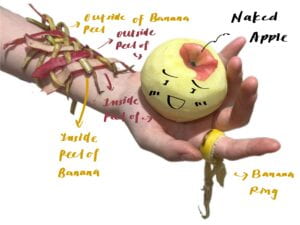
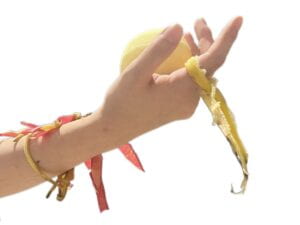
Seeing the unused banana peel beside us, I asked Chanel to help me make a wearable banana ring. When worn on the hand, the ring felt cool, soft, and resilient, which was incredibly comfortable. This made us realize that the same textile, when encountered or wrapped around the skin in different forms, can evoke very different sensations!
(By the way, I really enjoyed this in-class exercise because Chanel and I each ate half a banana, and I finished the apple 😏).
Leave a Reply